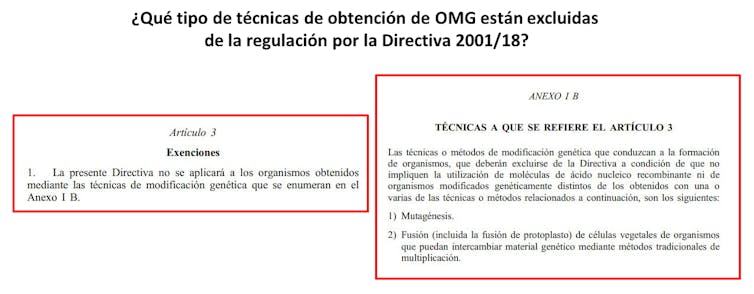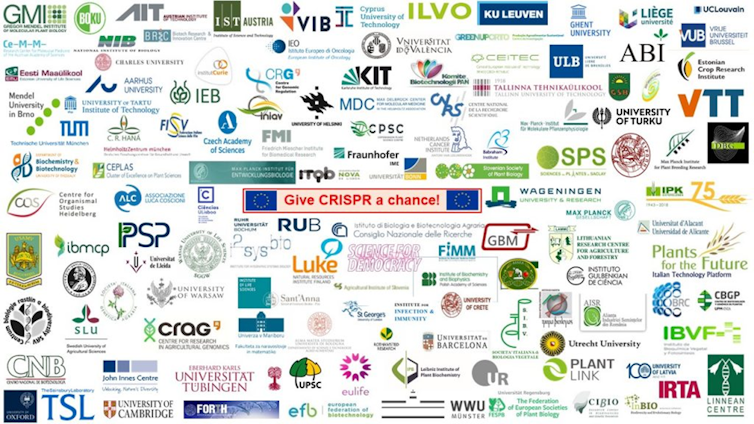A few days ago it jumped to the media a news agency Reuters that generated unusual excitement and expectations. It was announced that “in vitro gene editing in plants would no longer be regulated as GMOs” (GMO is the acronym for Genetically Modified Organism.) We were surely many scientists who believed that the European high court had corrected that July 2018 ruling in which he ruled that genetically edited organisms, for example with CRISPR tools, should be considered GMOs for all purposes. We put aside our traditional skepticism and we wanted to believe that the blockade to gene editing in Europe was over.
But no, the Reuters headline was incorrect. actually the european high court had ruled on a much lesser issue, confirming that certain types of mutagenesis (in vitro) should continue to be excluded from the regulation of the European Directive 2001/18. But without ruling on gene editing, which continues to be as blocked as before.
Europe and New Zealand remain on the sidelines
This is the penultimate chapter in an already long saga of events in which the European Union (together with New Zealand) continues without joining the majority optionwhich is none other than excluding from the regulation as GMOs new gene editing techniques such as promising CRISPR.
Our mission is to share knowledge and enrich the debate.
About us?
In plants, gene editing techniques are applied, fundamentally, to inactivate some gene and thereby achieve some improvement in the product, either in the growth of the plant, or in its adaptation to the environment. They can also be used to change (insert, delete, substitute) one or more bases in the genome, or to directly incorporate genetic variants from one variety to another. These forms of gene editing should not be classified as “Genetically modified organism”.
However, if we use CRISPR tools to incorporate a new gene into the genome of the edited plant, then we would already be generating what we know as a plant transgenicwhich would logically become regulated as a GMO.
A little history
The story behind the current blockade of gene editing techniques to produce gene-edited plants in the EU began in 2015. It was that year when a French farmers’ union petitioned the French courts that plant varieties obtained via mutagenesis were not excluded from the regulation as GMOs (“transgenics”), as indicated in Directive 2001/18.
They were referring to cases where plant breeders had exposed a series of plants to radiation (X-rays or Gamma rays) or chemical mutation. And then they had selected those mutant plants that produced faster, with more harvests per year or that produced larger products or with unique commercial characteristics. Both methods have been widely used to generate most of the edible varieties that we have in the supermarket today.
Well, the French justice raised the case to the High Court of the EU which, in a surprising judgment of July 2018 decreed that, although mutagenesis by radiation or chemical products was excluded from regulation as GMOs, new mutagenesis techniques (genetic editing) should continue to be considered as GMOs and regulated as any transgenic. In other words, they equated transgenesis with CRISPR gene editing.

A jug of cold water for biotechnology
Said judgment of July 2018 was a tremendous jug of cold water that directly expelled from the market any biotechnological project developed in Europe and based on CRISPR who would like to reach the European market. You have to know that in more than 20 years of application of the directive “only” it has been approved for cultivation in the European Union a single GMO variety, Bt maize, transgenicwith the toxin of the bacteria bacillus turingensisto combat the borer plague, caused by insects that attack it, which was approved in 1998.
Therefore, in Europe, when it is said “should be regulated by Directive 2001/18” This is synonymous with initiating a risk assessment procedure against human beings and the environment that usually entails expenses of around 10 million euros for the requesting company and extends for 5 to 10 years or, as often happens, extend without an end date.
All this condemns any experimental proposal and sends the message that it will never really be approved, regardless of the fact that in no case has any problem or impact on the environment or people been observed, as they recalled. 100 Nobel Prize Winning Scientists a few years ago. It is a case of raising the precautionary principle to the nth power that generates more harm than good. In fact, the consequences have been disastrous: the blocking of the cultivation of any new transgenic variety in the EU and, now, the blocking of the cultivation of any new variety obtained by gene editing.
After the publication of that ruling, thousands of scientists, scientific societies, research centers, companies in the sector and institutions who raised their voice against her, requesting a review of the same (something impossible, the court rulings cannot be appealed) or, at least, an intervention by the European Commission to change the directives and adapt them to new gene editing technologies.

Unsuccessful block attempt
But back to the Reuters news headline. What was he referring to then? To a group of French NGOs that returned to the fray after the July 2018 ruling and they asked the European high court again to include the classic mutagenesis techniques (random, by radiation or chemical mutagens) in vitro (in cells, in tissues) in regulation as a GMO.
Fortunately, the new attempt to block varieties obtained by radiation or chemical mutagenesis has failed. The high court of the EU I have answered that these mutagenesis techniques continue to be excluded from the regulation as GMOs by Directive 2001/18, confirming what had already been established by the EFSA itself (European Food Safety Agency) Two years ago.
Therefore, nothing is said in this new ruling on gene editing. They only refer to random mutation (the one obtained by radiation or chemical mutagens). Genetic editing techniques are still considered GMOs and continue to require, in an incomprehensible way, regulation by directive 2001/18, published more than 12 years before the use of CRISPR techniques was described gene editing in plants.













